Financial Analysis of Cost Reduction Techniques and Methods
VerifiedAdded on 2021/02/19
|7
|1407
|21
Report
AI Summary
This report provides a comprehensive analysis of cost reduction techniques, focusing on financial principles and their application in maximizing profitability. It begins with an introduction to cost reduction as a crucial financial technique and then delves into practical calculations for job costing, including the determination of direct and indirect costs. The report explores the basis of dealing with overheads, comparing different methods like activity-based costing and traditional methods. The core of the report examines Activity Based Costing (ABC), highlighting its importance, advantages, and criticisms. It emphasizes how ABC improves accuracy and accountability in manufacturing activities by assigning overhead expenses more logically. The report also includes practical examples, such as calculating the cost of a job under different overhead allocation methods (Option A and Option B), and explains the importance of selecting the most appropriate method for cost reduction. It also discusses the benefits of ABC in terms of improving the understanding of overhead costs and cost drivers, and its role in making informed pricing decisions. The report concludes by summarizing the key findings and the benefits of applying financial techniques for achieving business objectives efficiently.
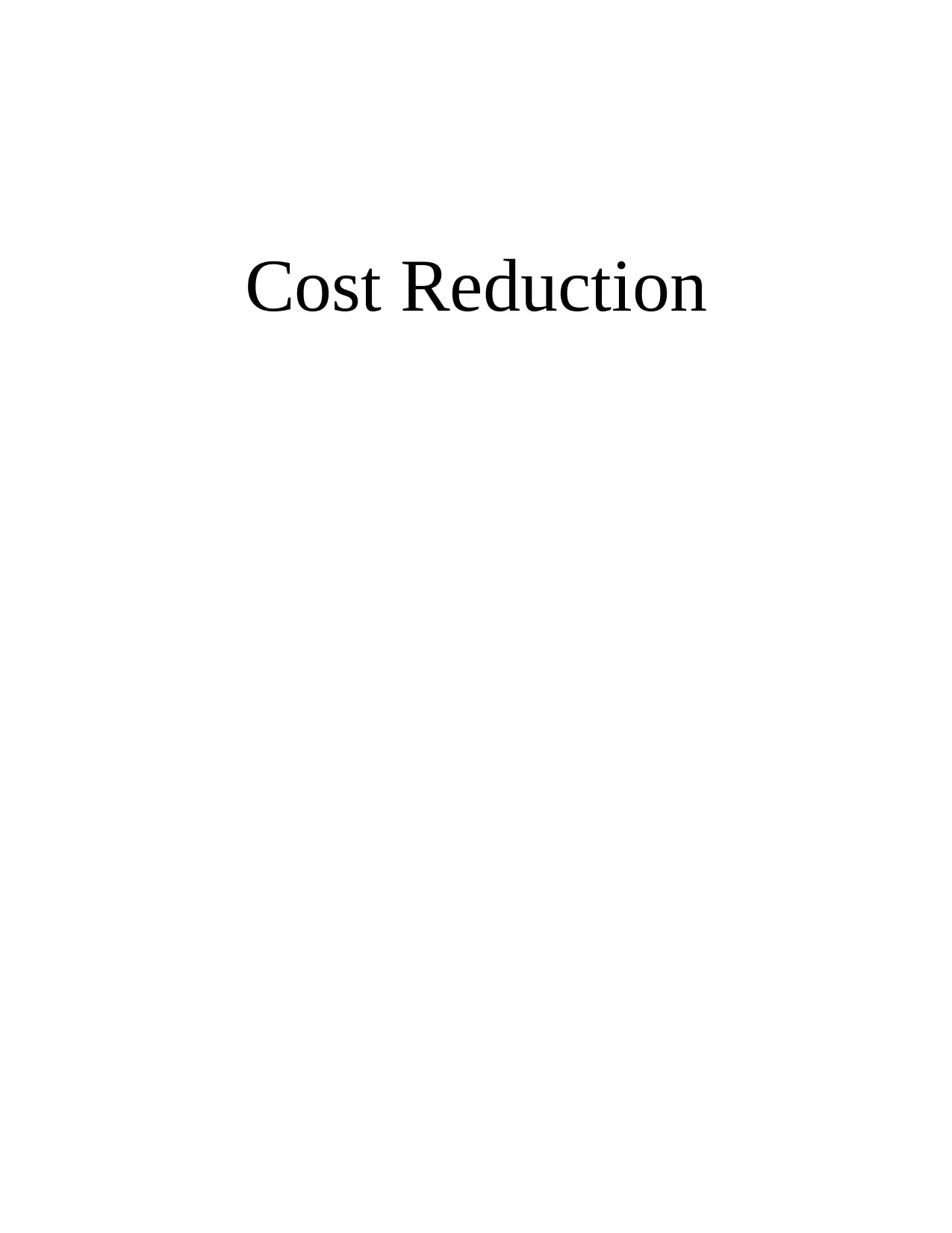
Cost Reduction
Paraphrase This Document
Need a fresh take? Get an instant paraphrase of this document with our AI Paraphraser
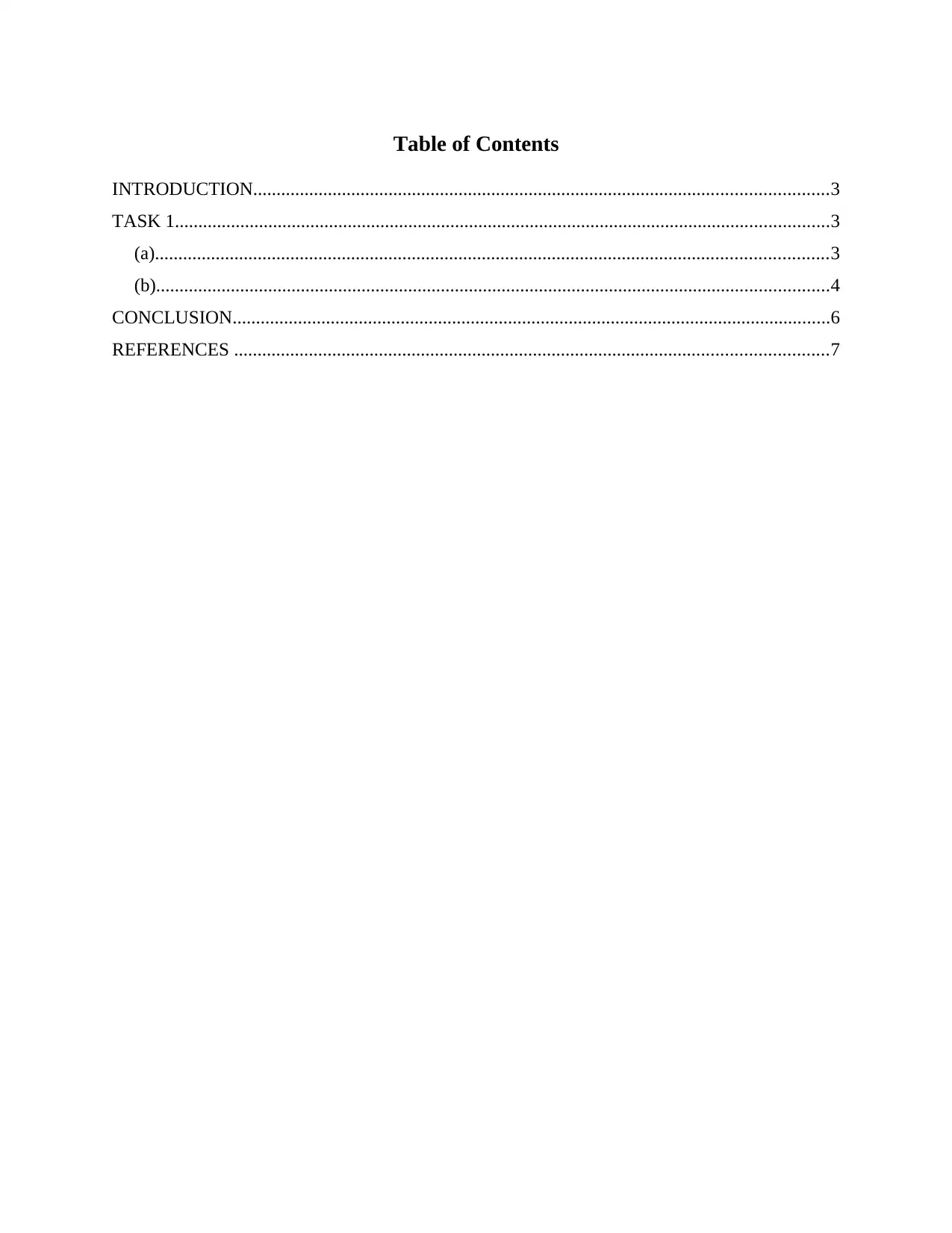
Table of Contents
INTRODUCTION...........................................................................................................................3
TASK 1............................................................................................................................................3
(a)................................................................................................................................................3
(b)................................................................................................................................................4
CONCLUSION................................................................................................................................6
REFERENCES ...............................................................................................................................7
INTRODUCTION...........................................................................................................................3
TASK 1............................................................................................................................................3
(a)................................................................................................................................................3
(b)................................................................................................................................................4
CONCLUSION................................................................................................................................6
REFERENCES ...............................................................................................................................7
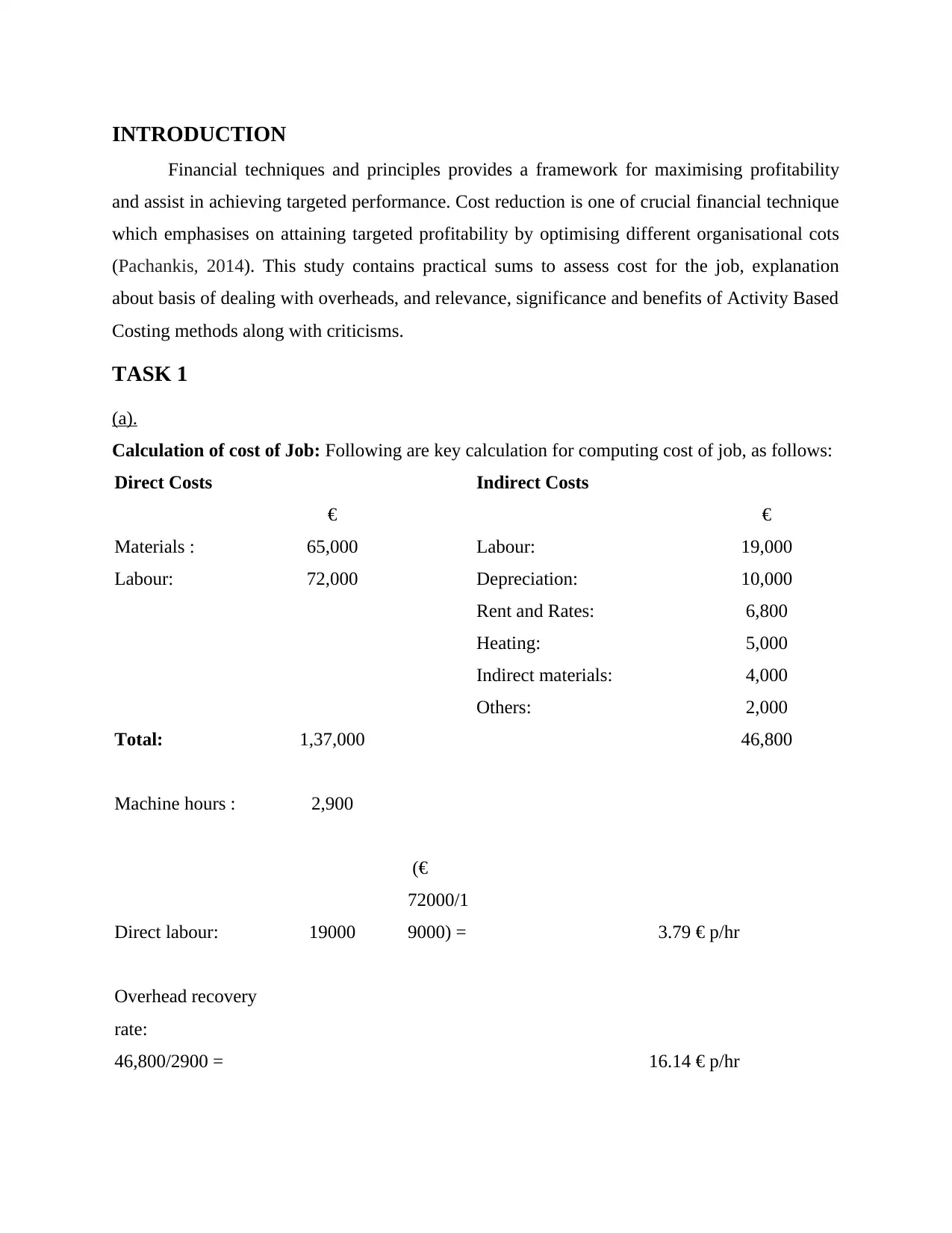
INTRODUCTION
Financial techniques and principles provides a framework for maximising profitability
and assist in achieving targeted performance. Cost reduction is one of crucial financial technique
which emphasises on attaining targeted profitability by optimising different organisational cots
(Pachankis, 2014). This study contains practical sums to assess cost for the job, explanation
about basis of dealing with overheads, and relevance, significance and benefits of Activity Based
Costing methods along with criticisms.
TASK 1
(a).
Calculation of cost of Job: Following are key calculation for computing cost of job, as follows:
Direct Costs Indirect Costs
€ €
Materials : 65,000 Labour: 19,000
Labour: 72,000 Depreciation: 10,000
Rent and Rates: 6,800
Heating: 5,000
Indirect materials: 4,000
Others: 2,000
Total: 1,37,000 46,800
Machine hours : 2,900
Direct labour: 19000
(€
72000/1
9000) = 3.79 € p/hr
Overhead recovery
rate:
46,800/2900 = 16.14 € p/hr
Financial techniques and principles provides a framework for maximising profitability
and assist in achieving targeted performance. Cost reduction is one of crucial financial technique
which emphasises on attaining targeted profitability by optimising different organisational cots
(Pachankis, 2014). This study contains practical sums to assess cost for the job, explanation
about basis of dealing with overheads, and relevance, significance and benefits of Activity Based
Costing methods along with criticisms.
TASK 1
(a).
Calculation of cost of Job: Following are key calculation for computing cost of job, as follows:
Direct Costs Indirect Costs
€ €
Materials : 65,000 Labour: 19,000
Labour: 72,000 Depreciation: 10,000
Rent and Rates: 6,800
Heating: 5,000
Indirect materials: 4,000
Others: 2,000
Total: 1,37,000 46,800
Machine hours : 2,900
Direct labour: 19000
(€
72000/1
9000) = 3.79 € p/hr
Overhead recovery
rate:
46,800/2900 = 16.14 € p/hr
⊘ This is a preview!⊘
Do you want full access?
Subscribe today to unlock all pages.

Trusted by 1+ million students worldwide
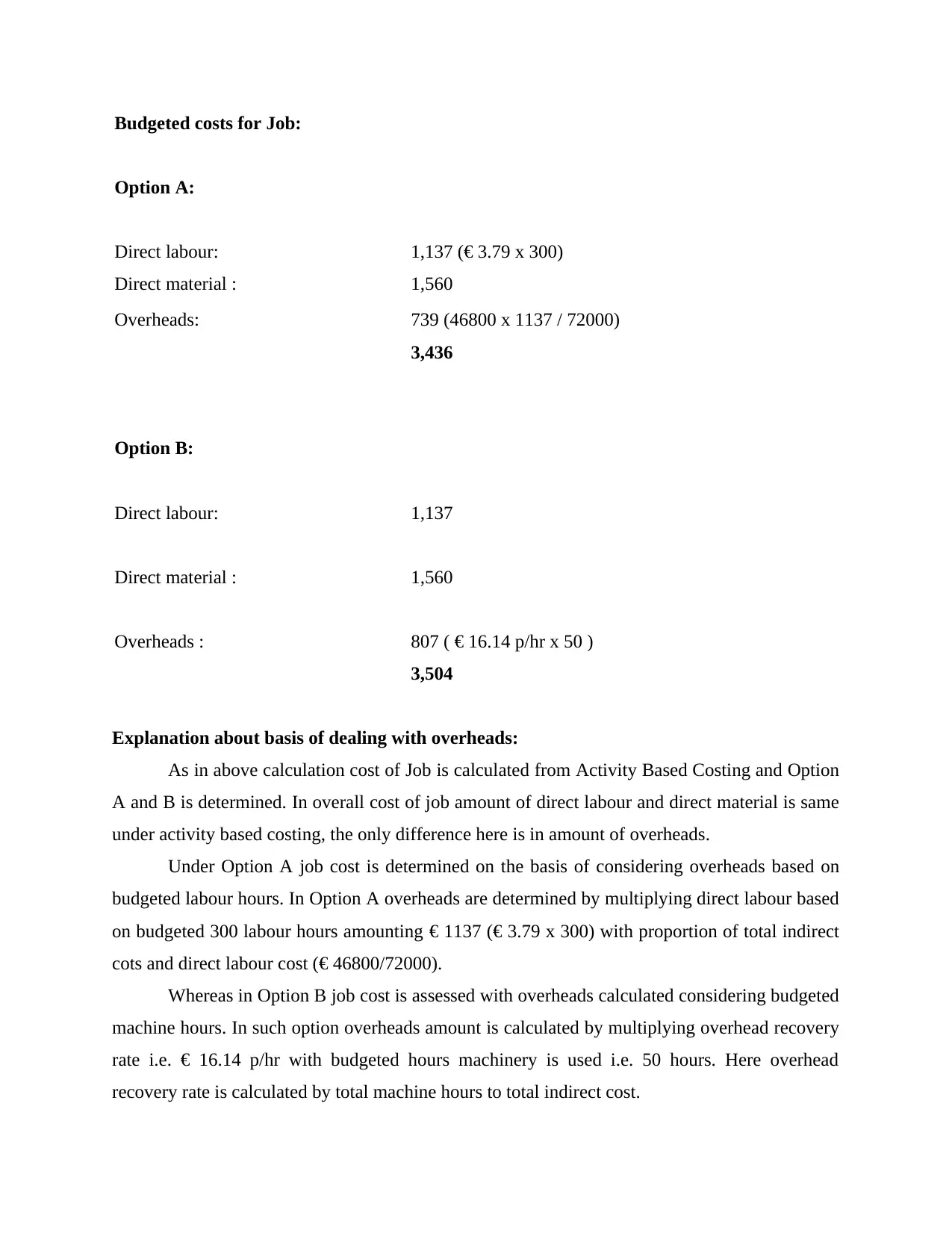
Budgeted costs for Job:
Option A:
Direct labour: 1,137 (€ 3.79 x 300)
Direct material : 1,560
Overheads: 739 (46800 x 1137 / 72000)
3,436
Option B:
Direct labour: 1,137
Direct material : 1,560
Overheads : 807 ( € 16.14 p/hr x 50 )
3,504
Explanation about basis of dealing with overheads:
As in above calculation cost of Job is calculated from Activity Based Costing and Option
A and B is determined. In overall cost of job amount of direct labour and direct material is same
under activity based costing, the only difference here is in amount of overheads.
Under Option A job cost is determined on the basis of considering overheads based on
budgeted labour hours. In Option A overheads are determined by multiplying direct labour based
on budgeted 300 labour hours amounting € 1137 (€ 3.79 x 300) with proportion of total indirect
cots and direct labour cost (€ 46800/72000).
Whereas in Option B job cost is assessed with overheads calculated considering budgeted
machine hours. In such option overheads amount is calculated by multiplying overhead recovery
rate i.e. € 16.14 p/hr with budgeted hours machinery is used i.e. 50 hours. Here overhead
recovery rate is calculated by total machine hours to total indirect cost.
Option A:
Direct labour: 1,137 (€ 3.79 x 300)
Direct material : 1,560
Overheads: 739 (46800 x 1137 / 72000)
3,436
Option B:
Direct labour: 1,137
Direct material : 1,560
Overheads : 807 ( € 16.14 p/hr x 50 )
3,504
Explanation about basis of dealing with overheads:
As in above calculation cost of Job is calculated from Activity Based Costing and Option
A and B is determined. In overall cost of job amount of direct labour and direct material is same
under activity based costing, the only difference here is in amount of overheads.
Under Option A job cost is determined on the basis of considering overheads based on
budgeted labour hours. In Option A overheads are determined by multiplying direct labour based
on budgeted 300 labour hours amounting € 1137 (€ 3.79 x 300) with proportion of total indirect
cots and direct labour cost (€ 46800/72000).
Whereas in Option B job cost is assessed with overheads calculated considering budgeted
machine hours. In such option overheads amount is calculated by multiplying overhead recovery
rate i.e. € 16.14 p/hr with budgeted hours machinery is used i.e. 50 hours. Here overhead
recovery rate is calculated by total machine hours to total indirect cost.
Paraphrase This Document
Need a fresh take? Get an instant paraphrase of this document with our AI Paraphraser
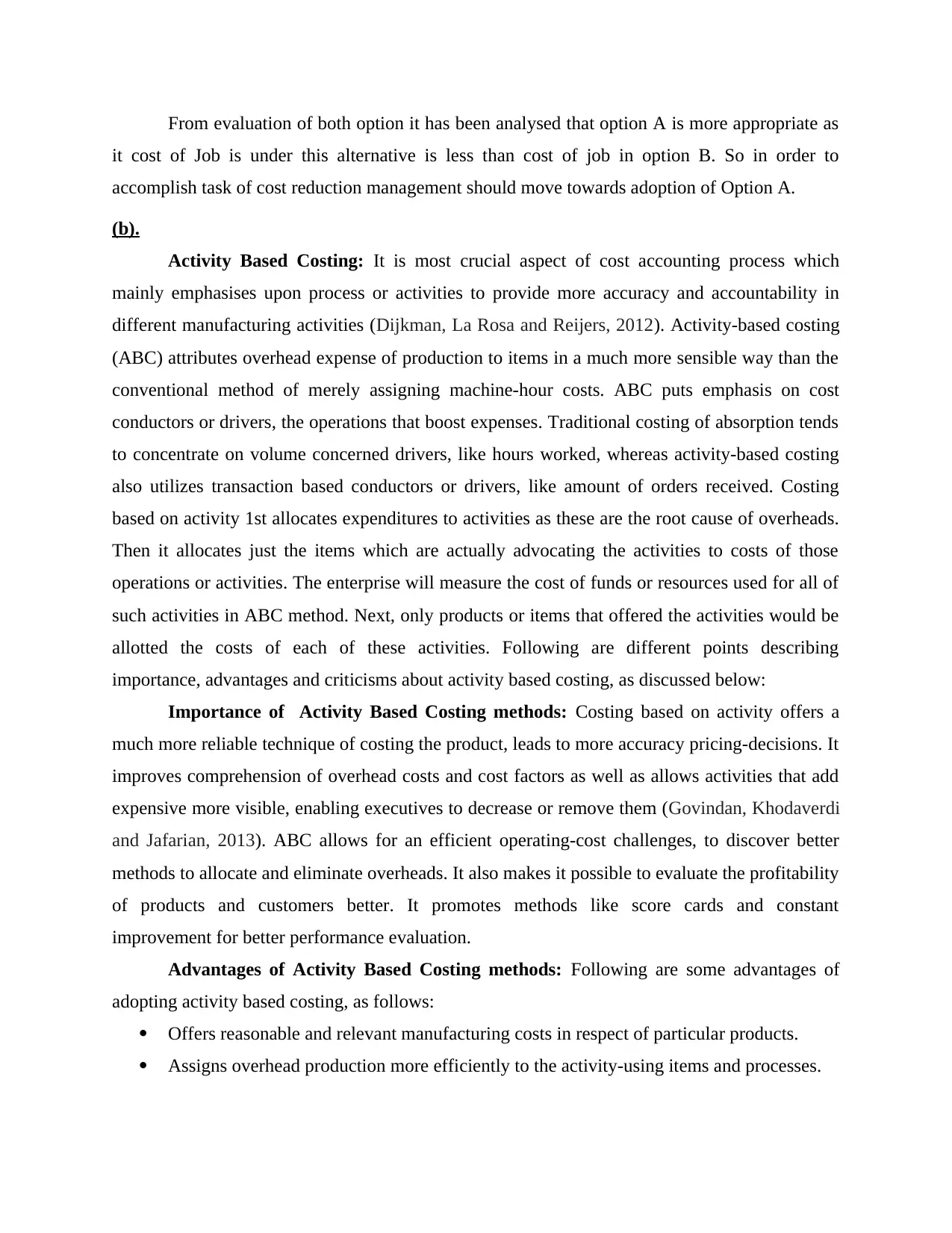
From evaluation of both option it has been analysed that option A is more appropriate as
it cost of Job is under this alternative is less than cost of job in option B. So in order to
accomplish task of cost reduction management should move towards adoption of Option A.
(b).
Activity Based Costing: It is most crucial aspect of cost accounting process which
mainly emphasises upon process or activities to provide more accuracy and accountability in
different manufacturing activities (Dijkman, La Rosa and Reijers, 2012). Activity-based costing
(ABC) attributes overhead expense of production to items in a much more sensible way than the
conventional method of merely assigning machine-hour costs. ABC puts emphasis on cost
conductors or drivers, the operations that boost expenses. Traditional costing of absorption tends
to concentrate on volume concerned drivers, like hours worked, whereas activity-based costing
also utilizes transaction based conductors or drivers, like amount of orders received. Costing
based on activity 1st allocates expenditures to activities as these are the root cause of overheads.
Then it allocates just the items which are actually advocating the activities to costs of those
operations or activities. The enterprise will measure the cost of funds or resources used for all of
such activities in ABC method. Next, only products or items that offered the activities would be
allotted the costs of each of these activities. Following are different points describing
importance, advantages and criticisms about activity based costing, as discussed below:
Importance of Activity Based Costing methods: Costing based on activity offers a
much more reliable technique of costing the product, leads to more accuracy pricing-decisions. It
improves comprehension of overhead costs and cost factors as well as allows activities that add
expensive more visible, enabling executives to decrease or remove them (Govindan, Khodaverdi
and Jafarian, 2013). ABC allows for an efficient operating-cost challenges, to discover better
methods to allocate and eliminate overheads. It also makes it possible to evaluate the profitability
of products and customers better. It promotes methods like score cards and constant
improvement for better performance evaluation.
Advantages of Activity Based Costing methods: Following are some advantages of
adopting activity based costing, as follows:
Offers reasonable and relevant manufacturing costs in respect of particular products.
Assigns overhead production more efficiently to the activity-using items and processes.
it cost of Job is under this alternative is less than cost of job in option B. So in order to
accomplish task of cost reduction management should move towards adoption of Option A.
(b).
Activity Based Costing: It is most crucial aspect of cost accounting process which
mainly emphasises upon process or activities to provide more accuracy and accountability in
different manufacturing activities (Dijkman, La Rosa and Reijers, 2012). Activity-based costing
(ABC) attributes overhead expense of production to items in a much more sensible way than the
conventional method of merely assigning machine-hour costs. ABC puts emphasis on cost
conductors or drivers, the operations that boost expenses. Traditional costing of absorption tends
to concentrate on volume concerned drivers, like hours worked, whereas activity-based costing
also utilizes transaction based conductors or drivers, like amount of orders received. Costing
based on activity 1st allocates expenditures to activities as these are the root cause of overheads.
Then it allocates just the items which are actually advocating the activities to costs of those
operations or activities. The enterprise will measure the cost of funds or resources used for all of
such activities in ABC method. Next, only products or items that offered the activities would be
allotted the costs of each of these activities. Following are different points describing
importance, advantages and criticisms about activity based costing, as discussed below:
Importance of Activity Based Costing methods: Costing based on activity offers a
much more reliable technique of costing the product, leads to more accuracy pricing-decisions. It
improves comprehension of overhead costs and cost factors as well as allows activities that add
expensive more visible, enabling executives to decrease or remove them (Govindan, Khodaverdi
and Jafarian, 2013). ABC allows for an efficient operating-cost challenges, to discover better
methods to allocate and eliminate overheads. It also makes it possible to evaluate the profitability
of products and customers better. It promotes methods like score cards and constant
improvement for better performance evaluation.
Advantages of Activity Based Costing methods: Following are some advantages of
adopting activity based costing, as follows:
Offers reasonable and relevant manufacturing costs in respect of particular products.
Assigns overhead production more efficiently to the activity-using items and processes.
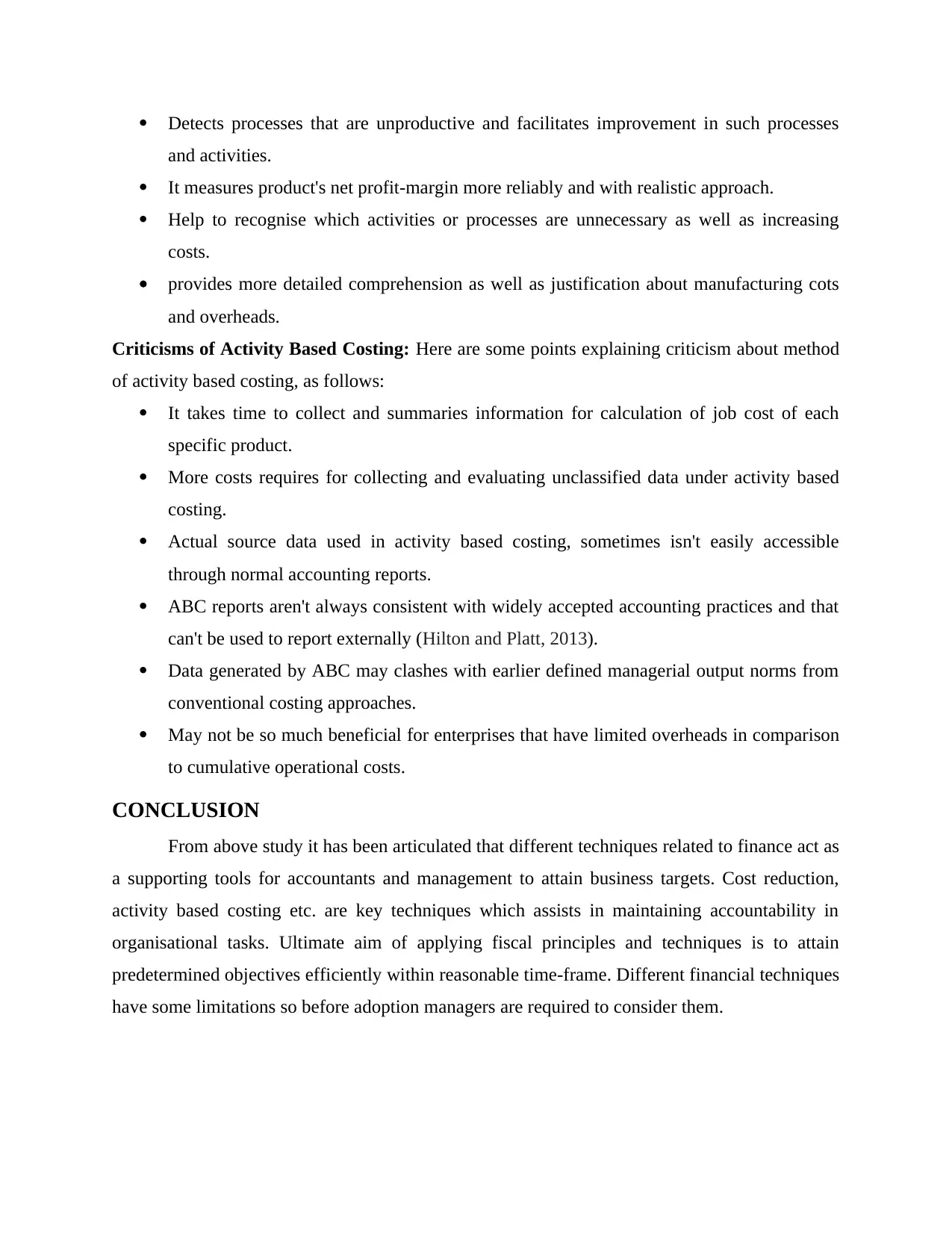
Detects processes that are unproductive and facilitates improvement in such processes
and activities.
It measures product's net profit-margin more reliably and with realistic approach.
Help to recognise which activities or processes are unnecessary as well as increasing
costs.
provides more detailed comprehension as well as justification about manufacturing cots
and overheads.
Criticisms of Activity Based Costing: Here are some points explaining criticism about method
of activity based costing, as follows:
It takes time to collect and summaries information for calculation of job cost of each
specific product.
More costs requires for collecting and evaluating unclassified data under activity based
costing.
Actual source data used in activity based costing, sometimes isn't easily accessible
through normal accounting reports.
ABC reports aren't always consistent with widely accepted accounting practices and that
can't be used to report externally (Hilton and Platt, 2013).
Data generated by ABC may clashes with earlier defined managerial output norms from
conventional costing approaches.
May not be so much beneficial for enterprises that have limited overheads in comparison
to cumulative operational costs.
CONCLUSION
From above study it has been articulated that different techniques related to finance act as
a supporting tools for accountants and management to attain business targets. Cost reduction,
activity based costing etc. are key techniques which assists in maintaining accountability in
organisational tasks. Ultimate aim of applying fiscal principles and techniques is to attain
predetermined objectives efficiently within reasonable time-frame. Different financial techniques
have some limitations so before adoption managers are required to consider them.
and activities.
It measures product's net profit-margin more reliably and with realistic approach.
Help to recognise which activities or processes are unnecessary as well as increasing
costs.
provides more detailed comprehension as well as justification about manufacturing cots
and overheads.
Criticisms of Activity Based Costing: Here are some points explaining criticism about method
of activity based costing, as follows:
It takes time to collect and summaries information for calculation of job cost of each
specific product.
More costs requires for collecting and evaluating unclassified data under activity based
costing.
Actual source data used in activity based costing, sometimes isn't easily accessible
through normal accounting reports.
ABC reports aren't always consistent with widely accepted accounting practices and that
can't be used to report externally (Hilton and Platt, 2013).
Data generated by ABC may clashes with earlier defined managerial output norms from
conventional costing approaches.
May not be so much beneficial for enterprises that have limited overheads in comparison
to cumulative operational costs.
CONCLUSION
From above study it has been articulated that different techniques related to finance act as
a supporting tools for accountants and management to attain business targets. Cost reduction,
activity based costing etc. are key techniques which assists in maintaining accountability in
organisational tasks. Ultimate aim of applying fiscal principles and techniques is to attain
predetermined objectives efficiently within reasonable time-frame. Different financial techniques
have some limitations so before adoption managers are required to consider them.
⊘ This is a preview!⊘
Do you want full access?
Subscribe today to unlock all pages.

Trusted by 1+ million students worldwide
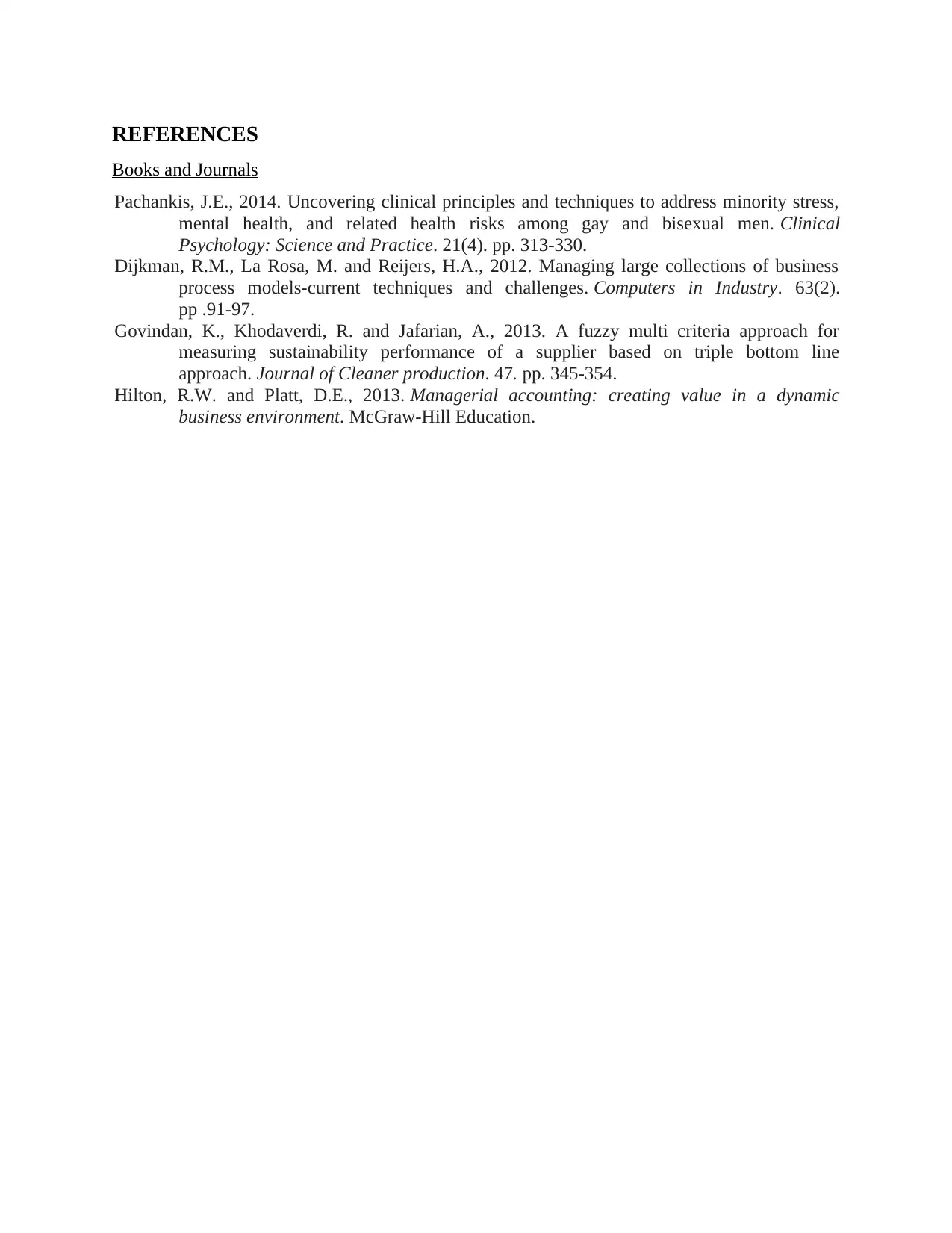
REFERENCES
Books and Journals
Pachankis, J.E., 2014. Uncovering clinical principles and techniques to address minority stress,
mental health, and related health risks among gay and bisexual men. Clinical
Psychology: Science and Practice. 21(4). pp. 313-330.
Dijkman, R.M., La Rosa, M. and Reijers, H.A., 2012. Managing large collections of business
process models-current techniques and challenges. Computers in Industry. 63(2).
pp .91-97.
Govindan, K., Khodaverdi, R. and Jafarian, A., 2013. A fuzzy multi criteria approach for
measuring sustainability performance of a supplier based on triple bottom line
approach. Journal of Cleaner production. 47. pp. 345-354.
Hilton, R.W. and Platt, D.E., 2013. Managerial accounting: creating value in a dynamic
business environment. McGraw-Hill Education.
Books and Journals
Pachankis, J.E., 2014. Uncovering clinical principles and techniques to address minority stress,
mental health, and related health risks among gay and bisexual men. Clinical
Psychology: Science and Practice. 21(4). pp. 313-330.
Dijkman, R.M., La Rosa, M. and Reijers, H.A., 2012. Managing large collections of business
process models-current techniques and challenges. Computers in Industry. 63(2).
pp .91-97.
Govindan, K., Khodaverdi, R. and Jafarian, A., 2013. A fuzzy multi criteria approach for
measuring sustainability performance of a supplier based on triple bottom line
approach. Journal of Cleaner production. 47. pp. 345-354.
Hilton, R.W. and Platt, D.E., 2013. Managerial accounting: creating value in a dynamic
business environment. McGraw-Hill Education.
1 out of 7
Your All-in-One AI-Powered Toolkit for Academic Success.
+13062052269
info@desklib.com
Available 24*7 on WhatsApp / Email
![[object Object]](/_next/static/media/star-bottom.7253800d.svg)
Unlock your academic potential
Copyright © 2020–2025 A2Z Services. All Rights Reserved. Developed and managed by ZUCOL.

